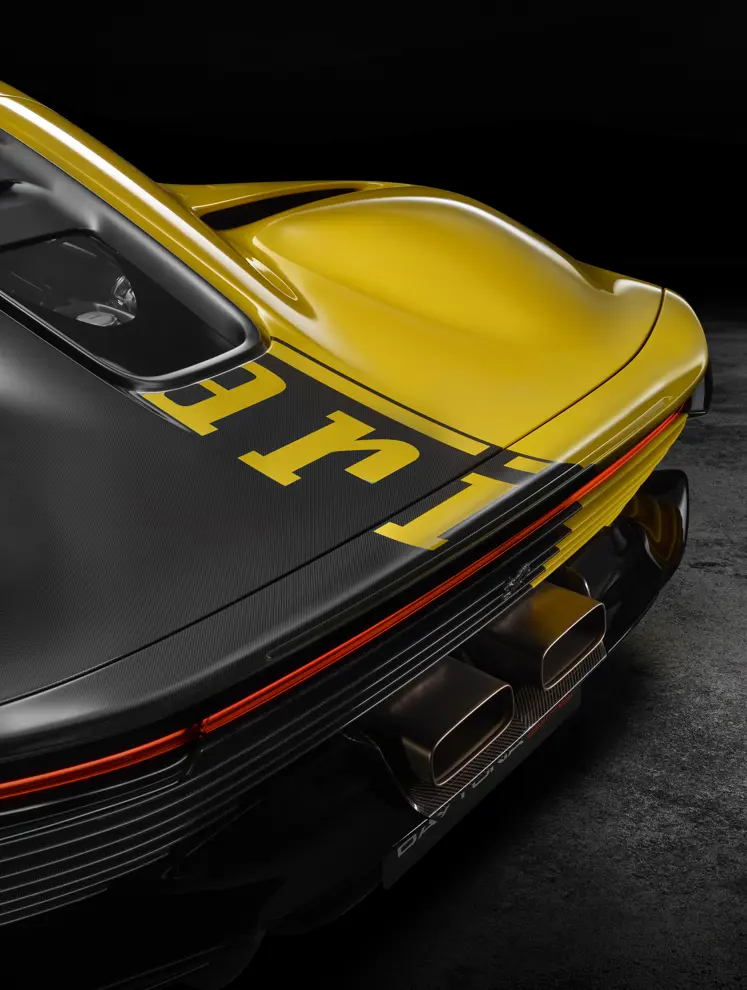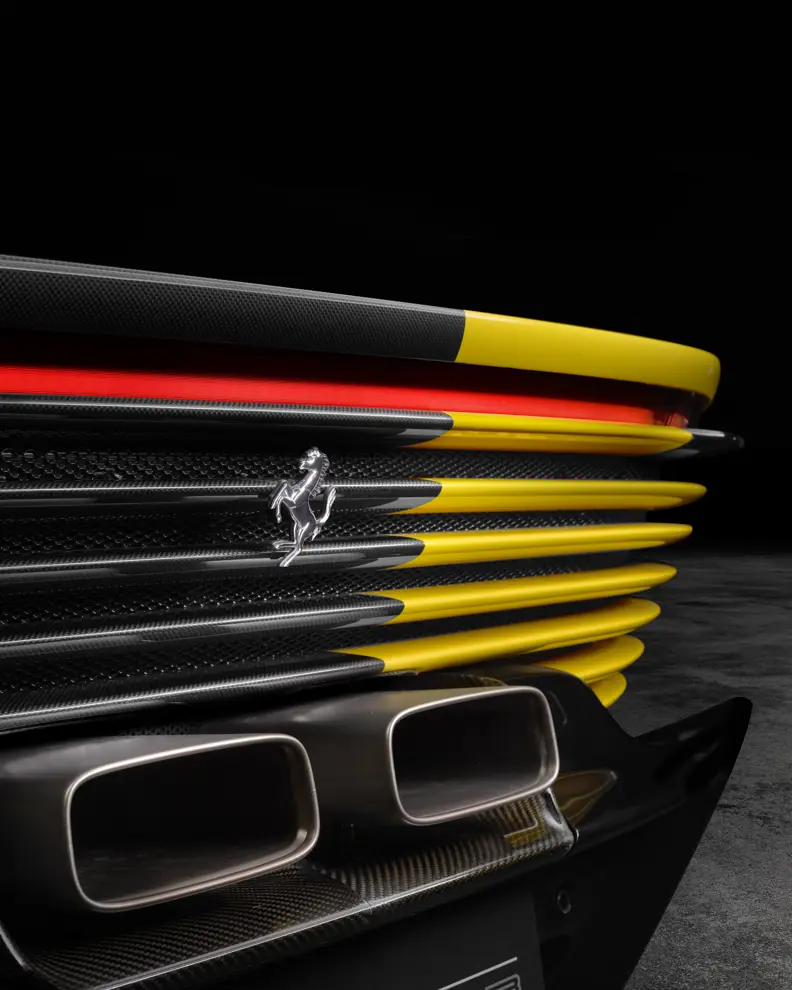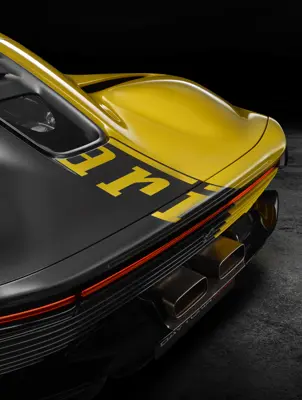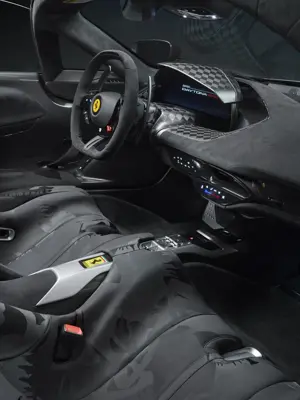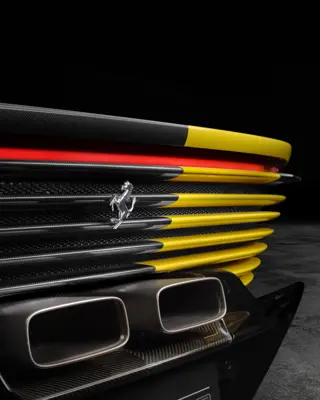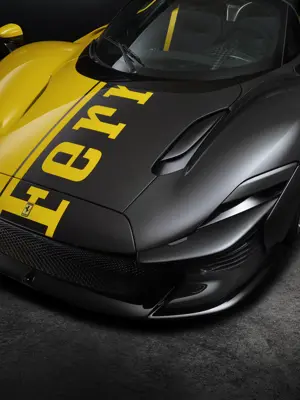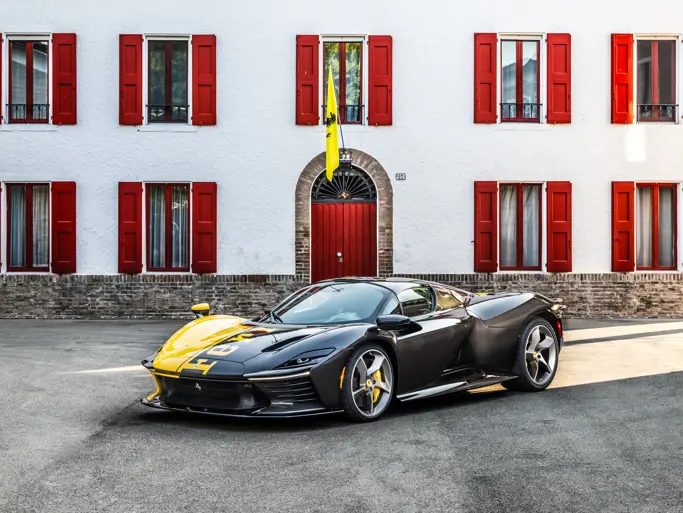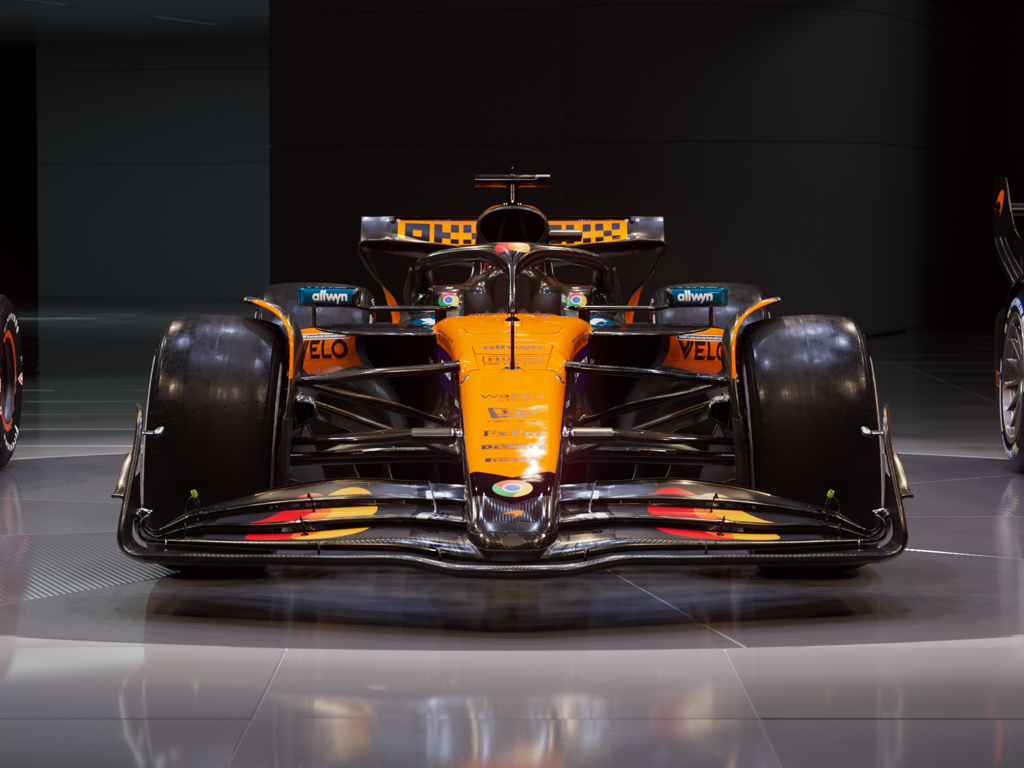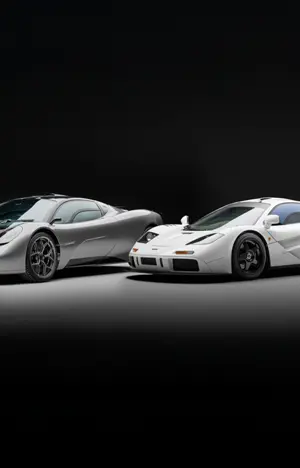Every Ferrari Daytona SP3 is special, but this example is a true one-off. Perhaps even more significant, it’s the only one that just about anyone can buy.
If you’re of a certain age, you’ll remember the spoof documentary—or ‘rockumentary,’ to quote the filmmaker—from 1984, This Is Spinal Tap, about a UK heavy rock band embarking on a US tour to promote its latest album. Blisteringly accurate and funny, it introduced the world to the concept of a music amplifier that could be turned up not to the usual ‘10’ on the dial but ‘11’—because, in the words of band member Nigel Tufnell, ‘11 is one louder.’
This year Ferrari produced the automotive equivalent of a Spinal Tap amplifier. The bespoke Daytona SP3 roadster that will be auctioned by RM Sotheby’s at the Monterey Conference Center in Monterey on 15-16 August bears a plaque with the chassis number 599+1, making it no louder than a regular SP3 but certainly the most exclusive—a one-off example built after the strictly limited production run of 599 cars ended. If you want the rarest of the rare, then 599+1 will be the one to have.
Not that there is such a thing as a ‘regular’ SP3, of course. These are all very special and individual cars, successors to the single-seater Monza SP1 and two-seater Monza SP2 that Ferrari launched in 2018 in its new Icona series. Those cars were no-compromise roadsters, lacking not only a roof but also a windscreen, whereas the Daytona SP3 gained both to make it globally road-legal as well as more usable. No point rolling up to your favourite hotel or restaurant in an uber-cool car if you appear to have been dragged through a hedge backwards when you arrive.
All three models are the work of Flavio Manzoni, Chief Design Officer at Ferrari since 2010, and his Centro Stile design team. Manzoni certainly appreciates classic Ferraris—he personally owns a 308 GTB—and it’s possible to discern, or at least imagine, design cues in the SP3 taken from several previous Ferrari greats. But, while he admits that the 330 P3/4 is his favourite historic Ferrari, he is also adamant that the SP3 looks to the future rather than the past. That’s very much on-brand and in keeping with founder Enzo’s famous aphorism that “my favourite Ferrari is the one that has yet to be built.”
“The Daytona SP3 was never intended as a nostalgic exercise or a literal interpretation of a specific past model,” Manzoni told this magazine. “Ferrari avoids that kind of approach—it would be anachronistic. With the SP3, we followed a similar path to the one we took with the Ferrari Monza. In this case, we saw the world of historic racing as a rich source of inspiration—not only for performance but also for design. Just as the Monza SP1/SP2 revived the ‘barchetta’ concept, the Daytona SP3 offers a modern interpretation of the ‘Sport Prototipo’—a category that, especially in the 1960s, played a pivotal role in Ferrari’s design legacy.”
Nevertheless, if you’re up for the challenge of playing ‘spot the design influence,’ there’s plenty to go at with the SP3. The cab-forward layout with deep wraparound windscreen and swelling front wings appear the most obvious homages to the P3/4, particularly the way the windscreen header rail drops down and is continued vertically to the body sides—just like a P3/4 Spider—as though a section has been cut straight down through the roof. The wasp waist (a particularly appropriate term on this yellow/black example) between the hugely elongated front wings and the rears is a more elegant variation of a trope exemplified by Pininfarina’s 1989 Mythos concept, and if you’re a real Ferrari concept car anorak you may pick up on the small inboard vents that anchor the rear wing tops to the centre of the body, almost exact replicas of those on a projected but never built roadgoing version of the 1970 512 S.
It's the SP3’s dramatic tail treatment, which consists of layered horizontal strakes sweeping around from the back of the rear wheel arches, that seems the strongest echo of the past: specifically, the Pininfarina 250 P5 of 1968. The two cars look incredibly similar here. However, while concepts never need to be particularly functional, that’s not the case for ultra-high-performance production cars. The SP3 features the most powerful non-assisted Ferrari V-12 ever, derived from the 812 Competizione and putting out 829 brake-horsepower at a screaming 9,250 rpm from its 6.5 litres on the way to a maximum of 9,500 rpm. Ferrari engineers went to extreme lengths to achieve this, redesigning the pistons, fitting lighter titanium con-rods and even coating the gudgeon pins with DLC—Diamond-Like Carbon—to reduce friction. Then there are the F1-inspired sliding steel finger followers in the valvetrain, which further minimise friction and help the V-12 snap through the rev range. At this rarefied level of technology, mention of the variable geometry inlet tracts seems almost passé.
Keeping the car glued to the road when it’s being assaulted by all that power and torque (514 pound-feet of the latter at 7,250 rpm) is no easy matter and the real triumph of Ferrari’s body designers has been to incorporate outstanding aerodynamics within the elegant looks—you only need to look at any modern F1 car to see how disparate those two criteria are. The SP3 has no active aerodynamics but it has the highest passive (that is, fixed rather than adjustable) aero of any Ferrari ever, generating 230 kilograms of downforce at 124 mph. And one of the main reasons that’s possible is because, unlike the LaFerrari Aperta platform on which the SP3 is based, it does without any of the electric hybrid components that compromise the chassis layout—notably, the battery packs that have to be mounted low down to avoid upsetting the car’s centre of gravity.
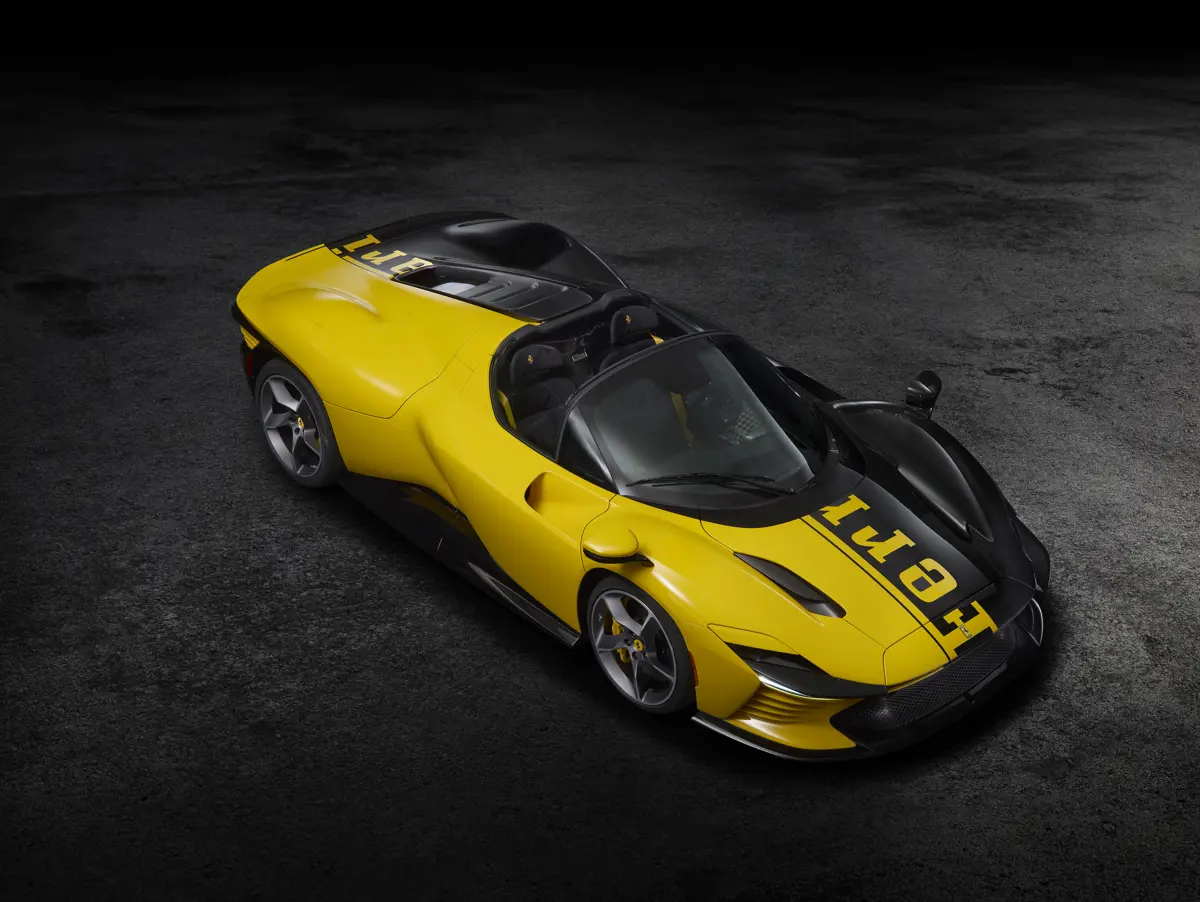
“The Daytona SP3’s chassis is derived from the LaFerrari,” Manzoni agrees, “but we introduced new aerodynamic channels that exit in front of the rear wheel arches. These ‘aero chimneys’ enhance ground effect. This innovation, made possible by repurposing space previously used for hybrid components in the LaFerrari, opened up new design possibilities. The two ‘gills’ on the sides of the SP3, just ahead of the rear arches, are a direct result of this aerodynamic solution.”
It seems that those horizontal slats at the rear, so similar to those on the 1968 Pininfarina 250 P5 concept, also have a practical purpose on the SP3. “They help dissipate engine heat—another example of how technical solutions can inspire design,” claims Manzoni. Because of the 6.5-litre V-12’s extreme power output, effective heat dispersion was a key requirement for the SP3, and Chief Technical Officer Michael Leiters has previously been quoted as saying that “there were lots of issues around thermal management. It makes a lot of heat…”
The SP3’s official dry weight is 1,485 kilograms, which seems broadly comparable with the LaFerrari Aperta’s—even though the former lacks the latter’s hybrid system—so ultimate performance cannot quite match the earlier car’s. But that wasn’t the top priority here, as Ferrari’s Head of Product Marketing, Emanuele Carando, explains.
“Every Ferrari is engineered to deliver exceptional performance, stunning design, and thrilling driving experiences. That said, in line with our product strategy—different Ferraris for different clients and moments—we balance these elements differently depending on the model.” Or, as British journalist Andrew Frankel put it less formally, driving an SP3 gives you a glimpse of what it feels like to be David Beckham or Lewis Hamilton when you turn up in one at an event. “To say it makes you feel like a millionaire is to criminally undersell its talent in this area. Billionaire is more like it and, I would surmise, more accurate too.”
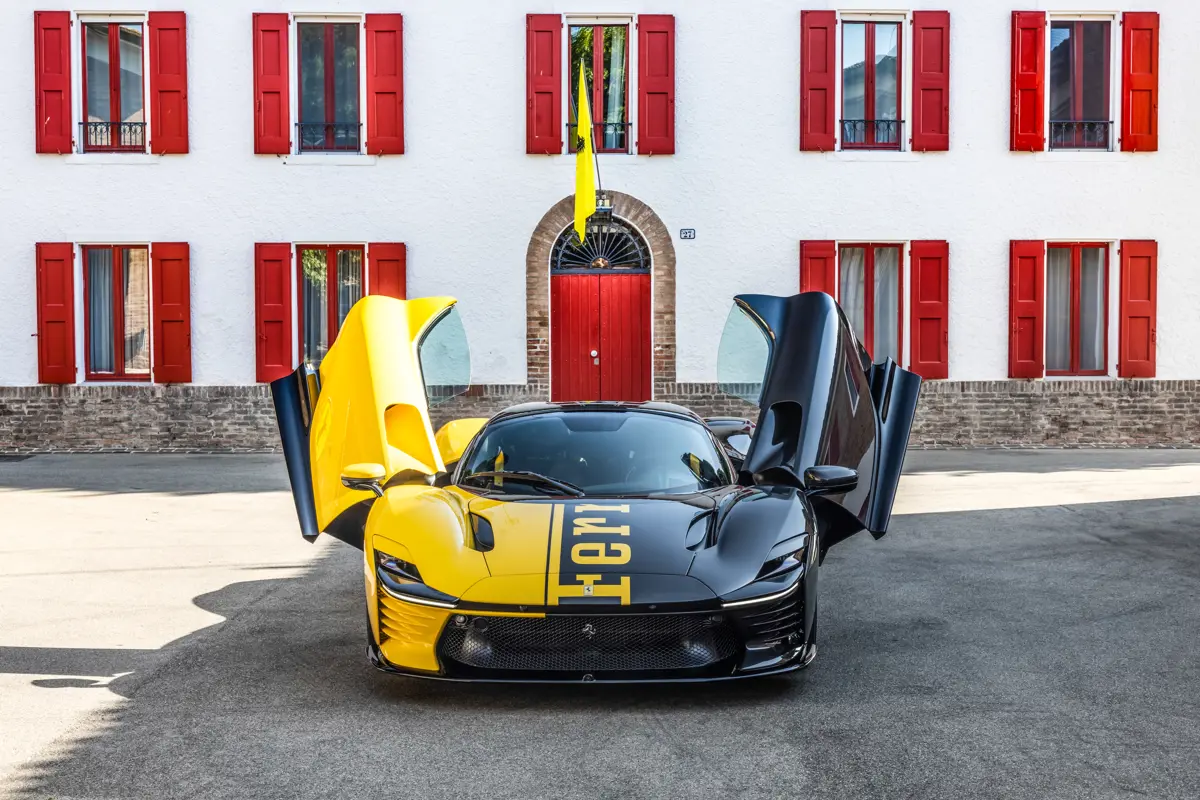
So, while you could certainly enjoy ragging an SP3 around a race circuit, the SP3 is emphatically not a track car. If you want to get a good idea of what it looks and sounds like on the road, however—especially the way that normally aspirated V-12 growls and rasps and snarls its way through the rev range—you can’t do better than seek out a recent episode of Jay Leno’s Garage on YouTube, in which Leno goes for a drive with SP3 owner and serial Ferrari collector David Lee. “This is my favourite kind of Ferrari,” Leno enthuses. “The new hybrids like the SF90 feel fast like a lot of cars feel fast. This feels fast the way Ferraris feel fast—and that’s what I find exciting.”
How fast? Well, put it this way: the quoted 0-62 mph time is so minimal, it needs to be measured to two decimal points at 2.85 sec. Top speed is reputedly 211 mph—340 km/h—although Ferrari hasn’t provided a lap time for the Fiorano test track. To quote Andrew Frankel once again, “You can say that for most multi-millionaires most of the time, it’s plenty fast enough.”
Those multi-millionaires will likely be able to confirm from personal experience that a key detail the SP3 shares with both the LaFerrari and the Enzo—other than versions of Ferrari’s F140 engine design and the carbon fibre tub—is that its seats are bolted direct to the floor, with the driver’s pedal assembly movable to allow for differently sized humans. That’s perfect for keeping occupant mass as low as possible and for optimising weight distribution, but it’s still a rare feature on road cars, even though it’s been common in racers for many decades. Having both seats mounted rigidly side by side also means the stylists have a little more freedom to link them together both physically and aesthetically; for chassis 599+1, they’ve used an innovative fabric derived from recycled tyres, while the dashboard and steering wheel are made of F1-type carbon fibre.
Racing is the origin of the Daytona SP3’s name, too, which has nothing to do with the moniker popularly associated (though not by Ferrari) with the 365 GTB/4 road car of the late ’60s/early ’70s. As Flavio Manzoni explains: “Since the Daytona SP3 is a modern reinterpretation of the 1960s Sport Prototipi, the name ‘Daytona’ was an obvious and immediate choice. Everyone remembers the 1967 24 Hours of Daytona, where Ferrari famously secured a 1-2-3 finish: first place went to the 330 P3/4 Spider (Bandini/Amon), second to the 330 P4 Coupé (Parkes/Scarfiotti), and third to a NART 412 P (Rodriguez/Guichet).”
However, Manzoni concedes that there is a link to later examples of the 365 GTB/4 Daytona, in the way that on the SP3 the headlights are concealed by sliding ‘eyelids’ when not in use. “My team and I have always wanted to reinterpret the concept of pop-up or partially hidden headlights, like those on the 365 GTB/4 and other later Ferraris. For the Daytona SP3, as part of the Icona project, we accepted the slight weight penalty that came with this feature. We enjoyed introducing this idea, treating it as a design challenge to make the car’s ‘gaze’ more expressive and aggressive.”
All 599 examples originally produced of the Daytona SP3 were presold by invitation to previous Ferrari customers. Of that number, 499 cars were reserved for past buyers of the Monza SP1 and SP2—every one of whom bought an SP3—and the remaining 100 were allocated to other favoured Ferrari customers; according to a story in The New Yorker’s 2023 Christmas issue, you needed to have already spent £30 million with Ferrari in order to be invited. Which perhaps will make the price realised by chassis 599+1 when it is auctioned by RM Sotheby’s in August at Monterey, with all proceeds going to support Ferrari’s educational initiatives, something of a cumulative bargain.
The 2025 Ferrari Daytona SP3 will go under the hammer at RM Sotheby’s Monterey auction on 15-16 August.


